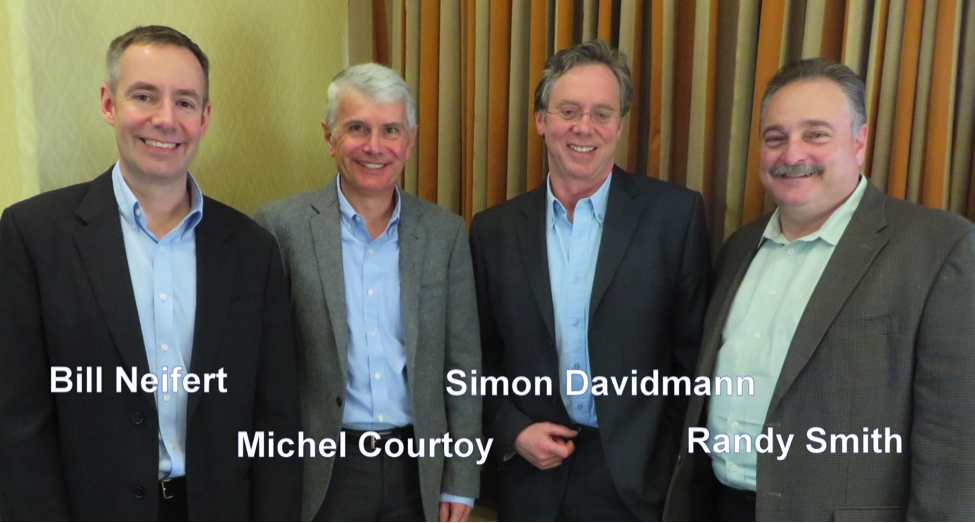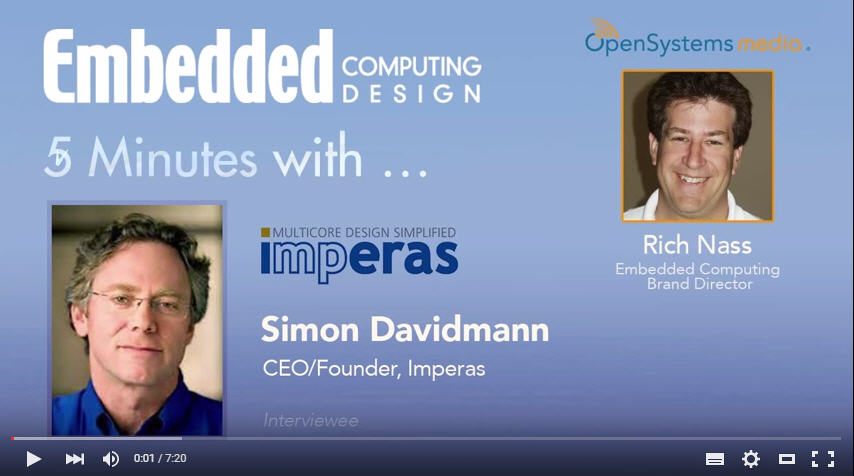Five Minutes With… Simon Davidmann, CEO/Founder, Imperas
Simon Davidmann, Founder and CEO of Imperas is a self-described "serial engineer." A what? Well, listen to the five-minute interview and you'll understand what that means.
As a long-time veteran of the EDA industry, Simon and Rich talked about ... click here to read more and listen to the audio interview.
Embedded Software Development with Virtual Platforms

Rome was certainly not built in a day and neither was your next embedded software project. In this week’s Fish Fry, Amelia Dalton of Electronic Engineering Journal takes a closer look at virtual platform-based methodology for embedded software development with Simon Davidmann (CEO - Imperas). Simon and Amelia discuss the advantages of the Open Virtual Platform Consortium. and how virtual platforms can speed up your design process.
Follow the link to…
In a recent article in Semiconductor Engineering, Ann Steffora Mutschler states that as designs become part of connected networks, so do the requirements for what’s needed to make it work properly.
Defining a system used to be relatively straightforward. But as systems move onto chips, and as those chips increasingly are connected with applications and security spanning multiple devices, the definition is changing.
This increases the complexity of the design process itself, and it raises questions about how chips and software will be designed and defined in the age of the Internet of Things/Everything. For example, will engineers be developing software-defined hardware, network-defined…
Larry Lapides of Imperas recently posted a guest blog at the Imagination MIPS processor blog site. it discusses topics related to Operating System bring up and how virtual platform and advanced tools can provide signiificant benefits.
Linux has become the general purpose operating system of choice for embedded systems, and is almost always supported for high end SoCs developed by semiconductor vendors. These SoCs now have multicore processors, and run symmetric multiprocessor (SMP) Linux. Most vendors start with the MIPS Linux distribution, then customize it for the specific SoC (requiring device tree changes), including the necessary drivers for the peripherals…
In a recent article in Semiconductor Engineering, Ann Steffora Mutschler explores examples of architectural strategies for getting the best performance out of a power budget.
Virtual platform developer Imperas Software's tools are being used for power estimation, to enable dynamic analysis of the impact of the complete software stack - OS, firmware, applications - on the power consumption of SoCs and systems, according to CEO Simon Davidmann. "We have seen various architectures used by our customers with power constraints. What most of these architectures have in common is heterogeneity: using the right processor for the appropriate task."
He sees the next step in this progression of system architectures as enabling optimized sharing of...
Follow the…
At the Imagination Technologies Silicon Valley Summit in May 2015 there was a series of presentation and discussions regarding Virtualization, Security and the prpl Foundation.
Imperas is a founding member of the prpl Foundation Security PEG (prpl Engineering Group) and is working to provide solutions to assist electronic product developers to remove risks associated with embedded software development.
Several videos were recorded regarding prpl at the IMG summit - these can be viewed on the prpl youtube channel here.
"The disciplines of hardware and software engineering have always been intertwined and symbiotic - like the yin and yang of some bizarre abstract beast. Software cannot exist without hardware to execute it, of course, and most hardware today is designed in the service of software. The vast majority of systems being designed today involve a mix of both elements working together, with software steadily inheriting more and more of the complexity load.
Let’s think about that for a minute..."
Follow the link to read the full article.
##
At the DVCon conference in Santa Clara in April, Brian Bailey of Semiconductor Engineering hosted a round table discussion on the state of EDA and the opportunities for new startups to grow and succeed. Imperas CEO and OVP founder, Simon Davidmann was part of the discussion.

Other participants were Bill Neifert, chief technology officer at Carbon Design Systems; Randy Smith, vice president of marketing for Sonics; and Michel Courtoy, vice president of marketing and business development for Kilopass Technology.
The discussion is being reported in 3 posts by Brian. There are links to them below.
In a snippet from…
Recently Electronic Engineering Journal (EEJournal)'s Jim Turley wrote an interesting article on Imperas and the view that Imperas takes regarding software development.
"... Imperas thinks that programmers, as a class and as a profession, could stand to learn a few hard lessons from their colleagues over on the hardware side of the house. Specifically, the SoC and ASIC designers. Now those guys have got their stuff together. You could learn a few things from them. So what do the hardware guys do that the software people don’t? They simulate, mostly. They simulate the..."
"... The idea is that you simulate your code running on a simulated processor with simulated peripherals and simulated APIs. Everything runs on a standard x86-based PC; the more CPU cores it has, the…



